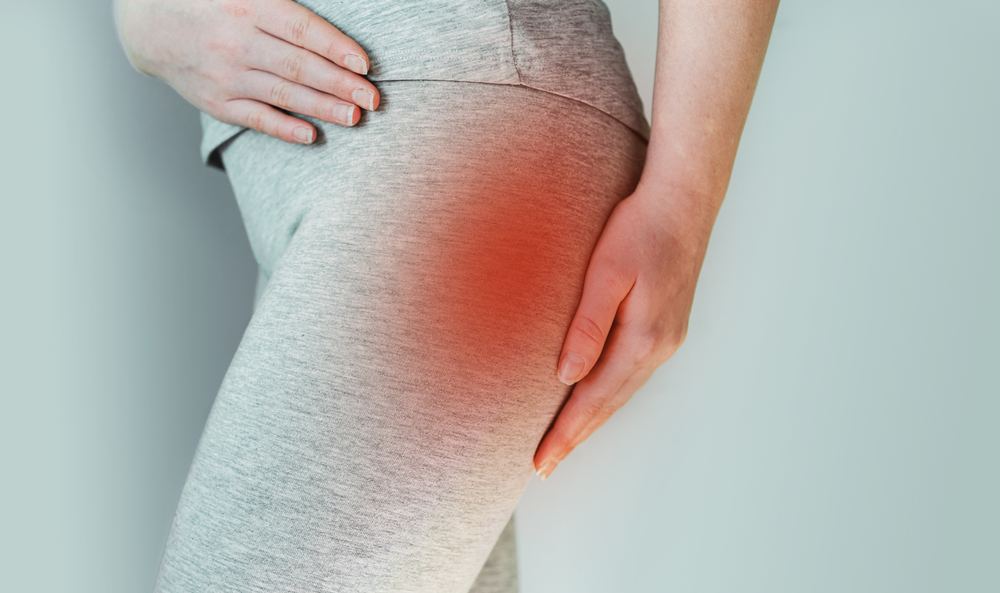The condition known as sciatica may be commonly known as a sharp pain that begins in the lower back and buttocks and can travel down the leg. But sometimes, there is a different type of pain that can be felt in the hip, buttocks, upper leg, or even lower in the leg. This irritation further down the leg is likely linked to sciatica. More often, this type of pain is due to an injury of some sort, specifically to the piriformis muscle located in the buttocks. This injury and pain is known as piriformis syndrome and although it feels similar to herniated disc pain or sciatica, it is an injury of its own that can be disabling.
What Is Piriformis Syndrome?
 The piriformis muscle is a muscle in the body that runs from the lower spine, through the buttocks, and down through the thigh. It runs along both sides of the body and is used in almost every lower body movement. For instance, the piriformis muscle is used in movements such as moving the hip bone away from the body, facilitating walking, rotating the hips inward and outward, stabilizing the hip joint, and turning out the leg or foot. This muscle wraps around the sciatic nerve. The sciatic nerve also runs from the spinal cord, down through the buttocks and into the leg on both sides of the body and is the longest nerve in the body. When the flat, narrow piriformis muscle compresses the sciatic nerve, usually because of stress or injury, it leads to swelling and inflammation on either side of the body. This inflammation is often the cause of the pain or numbness in the buttocks that runs down the leg. This syndrome is not very common and is the cause of lower back or leg pain only 0.3% to 0.6% of the time, but should it be the result of your pain after a car accident injury in Jonesboro, it can be quite painful and debilitating.
The piriformis muscle is a muscle in the body that runs from the lower spine, through the buttocks, and down through the thigh. It runs along both sides of the body and is used in almost every lower body movement. For instance, the piriformis muscle is used in movements such as moving the hip bone away from the body, facilitating walking, rotating the hips inward and outward, stabilizing the hip joint, and turning out the leg or foot. This muscle wraps around the sciatic nerve. The sciatic nerve also runs from the spinal cord, down through the buttocks and into the leg on both sides of the body and is the longest nerve in the body. When the flat, narrow piriformis muscle compresses the sciatic nerve, usually because of stress or injury, it leads to swelling and inflammation on either side of the body. This inflammation is often the cause of the pain or numbness in the buttocks that runs down the leg. This syndrome is not very common and is the cause of lower back or leg pain only 0.3% to 0.6% of the time, but should it be the result of your pain after a car accident injury in Jonesboro, it can be quite painful and debilitating.
The Difference Between Piriformis Syndrome and Sciatica
Because piriformis syndrome and sciatica are very similar conditions with similar types of pain, it can be difficult to diagnose piriformis syndrome. Both of these conditions interfere with the sciatica nerve function. Sciatica, however, is the result of a herniated disc or other spinal dysfunctions, while piriformis syndrome is caused by compression of the muscle on the sciatic nerve. Because the symptoms of piriformis syndrome mimic sciatica, there are certain tests that can be done to determine if it is sciatica or piriformis syndrome. In general, piriformis syndrome tends to be more focused on one side of the buttocks and is aggravated by sitting, but it is recommended that you work with an expert medical professional at AICA in Jonesboro to thoroughly evaluate your symptoms and pain for proper diagnosis and treatment.
Causes of Piriformis Syndrome
Anything that causes the piriformis muscle to press on the sciatic nerve will cause piriformis syndrome. There are three common causes of this: inflammation, muscle spasms, or scarring of the piriformis muscle. But what can lead to inflammation, muscle spasms, or scarring? These issues may be a result of one or more of the following:
- Exercising without enough piriformis muscle, such as walking, running, or climbing (weak muscle strength)
- Not stretching before exercising
- Overexercising, such as long-distance running
- Injury of the leg, buttocks, or hip in an accident such as a car accident or fall
- Sitting for long periods of time, especially at a job that requires a lot of sitting
- Tight muscles
- Improper lifting of heavy objects
- Body anatomy, such as a sciatic nerve that takes an improper path through the body or an unusually formed piriformis muscle- known as primary piriformis syndrome
Symptoms of Piriformis Syndrome
Piriformis syndrome can present differently for everyone. Some common signs and symptoms of piriformis syndrome can include:
- Pain in the buttocks, especially when sitting with legs crossed
- Pain when sitting, standing, or walking for more than 20 minutes
- Pain that improves with movement
- Foot numbness
- Pain when standing up or squatting
- Pain radiating from the back and buttocks down through the back of the thigh
- Paraesthesia, or a pins and needles sensation that can be accompanied by burning, numbness, itching, or a tingling sensation that radiates from the back through the buttocks and down the thigh
Piriformis Syndrome After A Car Accident
The force of a car crash often results in car accident injuries. Many people who suffer a car accident can injure the lower lumbar and hips. Damage to the piriformis muscle can occur as a result of a car accident. While not always as serious or as noticeable soon after an accident as a broken bone, it can be extremely painful. Oftentimes, injuries resulting from a car crash will not begin to cause problems until days or even weeks after the accident occurred.
It is recommended that you see a medical professional right after an accident and again, if necessary, when signs and symptoms of other injuries begin to present themselves. Medical professionals at AICA in Jonesboro are experienced in diagnosing and treating the often delayed symptoms of injuries that occur after a car accident to provide the very best in care for healing and relief.
Diagnosis and Treatment of Piriformis Syndrome
 Diagnosis of piriformis syndrome can be difficult. The best method for diagnosing this syndrome is to first rule out other potential problems or causes of pain. A healthcare provider will usually begin by asking questions such as what are your activities and habits, what is your medical history, and what other injuries you have experienced. They may also stretch, rotate, press, or move your hip to see where the pain and injury may have occurred. To get a closer look at the tissue and muscles, healthcare professionals may also order x-rays, an ultrasound, MRI, a CT scan, or EMG (electromyogram) to confirm the diagnosis. One of the most common ways to diagnose piriformis syndrome is to cause pain and symptoms by injecting the muscle. Additional testing by a healthcare professional to determine that it is piriformis syndrome and not sciatica can include:
Diagnosis of piriformis syndrome can be difficult. The best method for diagnosing this syndrome is to first rule out other potential problems or causes of pain. A healthcare provider will usually begin by asking questions such as what are your activities and habits, what is your medical history, and what other injuries you have experienced. They may also stretch, rotate, press, or move your hip to see where the pain and injury may have occurred. To get a closer look at the tissue and muscles, healthcare professionals may also order x-rays, an ultrasound, MRI, a CT scan, or EMG (electromyogram) to confirm the diagnosis. One of the most common ways to diagnose piriformis syndrome is to cause pain and symptoms by injecting the muscle. Additional testing by a healthcare professional to determine that it is piriformis syndrome and not sciatica can include:
- Manipulating the piriformis muscle to check for pain or tenderness
- Checking for tenderness around the sacroiliac joint
- Flexing your hip at a 90-degree angle and extending the knee to check for localized pain when pressure is applied to the piriformis muscle (this is known as a positive La Seque sign)
- A positive Pace Sign, which is pain or weakness when asked to resist the pressure of the hope or externally rotate the hip when seated
- Pain when lying on the asymptomatic side and the symptomatic leg is lifted and flexed
- Pain as a result of the FAIR test, Flexion, Adduction, and Internal Rotation
Any number of these tests may be performed to distinguish piriformis syndrome from similar sciatica symptoms.
Surgery is not usually required for the treatment of piriformis syndrome. In extreme cases, surgery may be required to remove scar tissue or alleviate pressure on the sciatic nerve. However, pain can usually be managed both at home and with the help of a medical provider through:
- Rest
- Stretching and strengthening the piriformis muscle
- Treating with anti-inflammatory medications
- Steroid injections
One of the most common treatments for piriformis syndrome is physical therapy.
Working with a physical therapist at AICA in Jonesboro can aid in stretching and strengthening the affected muscle. A physical therapist can give you proper exercises to perform at home as well that will continue to promote healing. With proper treatment, symptoms will usually improve within days or weeks.
Continued treatment can be required to keep symptoms from returning. If stretching and strengthening exercises are performed regularly, symptoms will often return. If piriformis syndrome is not treated, it can worsen and greatly reduce function and quality of life. It is imperative that you receive proper treatment and care from knowledgeable healthcare providers at AICA.
Stretching for Piriformis Syndrome
 Stretching is one of the best ways to find relief from piriformis syndrome. Some common stretches that can help alleviate pain are:
Stretching is one of the best ways to find relief from piriformis syndrome. Some common stretches that can help alleviate pain are:
- Foam roll piriformis stretch – sit on top of the foam roll with it positioned under the hip. Cross the leg over the other with the foot on the opposite knee and roll the foam roller along the back of the hip, especially over the tender spots.
- IT (iliotibial) stretch – lie on your side with the foam roll under the hip.
Cross the top leg over the leg on the foam roll with the foot on the floor while the leg on the foam roll remains up in the air throughout the exercise. Roll from the hip to the knee, along the outer thigh, down the hip and knee for 30 seconds, and apply pressure on tender spots
- Quad stretch – lie on your stomach with the foam roll under the thigh and support your upper body on your arms. Roll down the front of the thigh, applying pressure on the tender spots for 30 seconds.
While stretching can do wonders to relieve piriformis pain, it may not alleviate it entirely. For expert care and treatment to eliminate pain and find relief, AICA healthcare professionals can help. Contact our offices in Jonesboro today to schedule an appointment.
